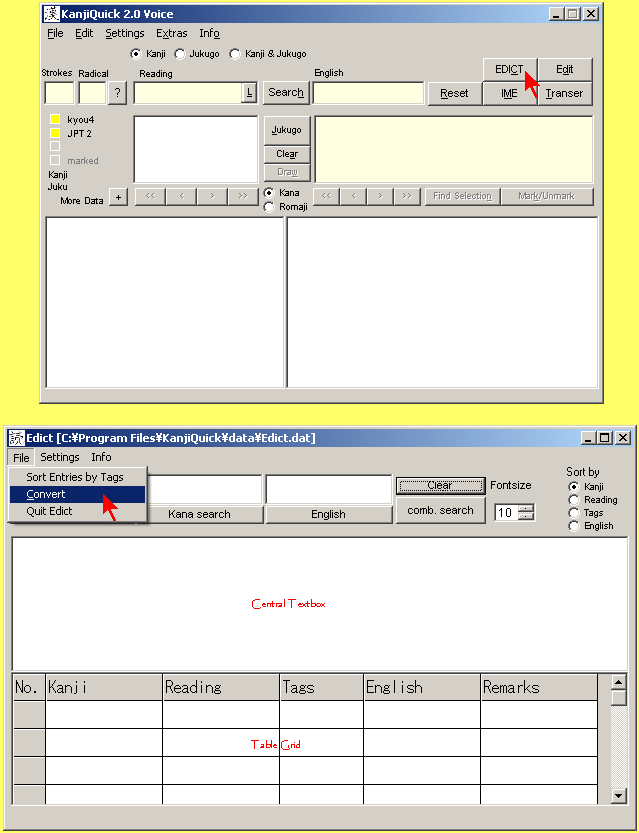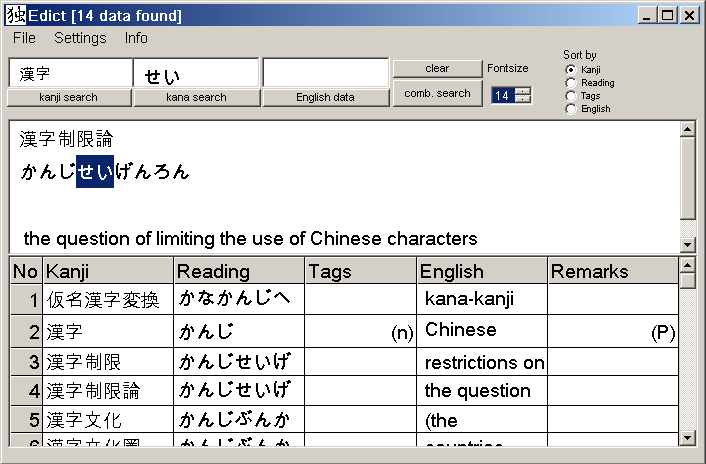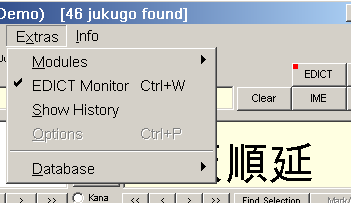| KanjiQuick Voice Documentation |
| [ Home Page | Downloads | Registration ] |
| [ Contents ] EDICT ReaderWhat can this program do for me?EDICT Reader enables you to search for Japanese and English words and their translations in a database compiled from the EDICT dictionary file of The Electronic Dictionary Research and Development Group, Monash University © 2002. Presently, this file has more than 100,000 entries. Since this is a dictionary file listing many words not written in kanji, you may find additional information not contained in KanjiQuick. Also, KanjiQuick may be used to identify kanji found in EDICT. You should first download a recent EDICT version. As the file is updated often, here is the URL for downloading and more information about EDICT. Save the EDICT file to your KanjiQuick data folder or move it there after downloading. If EDICT comes as a compressed file (e.g. EDICT.zip, EDICT.exe), it must be decompressed before you can use it.
For conversion of EDICT to database format, click the button in the upper right corner of KanjiQuick's main program , which will load the EDICT Reader module. Then choose File > Convert from the EDICT Reader menu and follow the instructions. If you previously loaded an older version of the EDICT database file, you should delete or move it from the KanjiQuick data folder before you start the conversion. The EDICT converter will warn you if the EDICT file you have downloaded is corrupted or if you are about to convert a version which is not newer than your present EDICT database. EDICT Reader is very easy to use. There are 4 ways to search for entries: Results are displayed in the table grid . Click on any line to move its data to the central textbox . Matches may be sorted according to different criteria. You may choose 5 different font sizes.
How to use EDICT Reader1. Choose database 2. Search string input EDICT Reader is linked with KanjiQuick . When EDICT Reader is launched from KanjiQuick, any text in the Jukugo or Kanji display box will be displayed in the EDICT Reader kanji search box , so it is easy to search for EDICT Reader entries matching a character you have found in KanjiQuick. You may drag and drop text from KanjiQuick to EDICT Reader and vice-versa. Drag and drop characters into the EDICT kanji input box from KanjiQuick's main window display boxes , or the Kanji , Jukugo , or Items Lists . Do not Drag & Drop characters from the Results List or Text Analysis Text input box . The Drag & Drop will function, but the data you drag away will no longer be in the source text, since both of these files may be edited or saved by you. If you wish to perform an EDICT search on a string in either of these sources, first highlight it and double-click on the string, then drag it from the Kanji or Jukugo List that appears. In order to allow direct Japanese language input, Japanese language support (MS IME) must be enabled. Note that pattern matching is activated for search criteria in all input fields. Thus, if you input any string, EDICT Reader will display all entries containing this string within a phrase or a single word. For example if you input "nation," EDICT Reader will also display matches like "national," "explanation," and "international." You may search for single words by entering spaces before and after the string, or search for words ending with "nation" by entering a space only after the search string. Pattern matching can be disabled for English search criteria only. Choose Settings > Auto Wildcard from the menu to enable or disable. If disabled, you may still use pattern matching by entering * or ? as appropriate. Capitalization is ignored in a search. Click the button to delete all entries. The maximum number of matches displayed is 5,000. If your search yields more matches than this, you are requested to modify your search criteria in order to reduce the number of matches. You may choose 1,000 or 2,000 as the maximum number to speed up output to the display. 3. Start search 4. Display results 5. Display single entries in the central textbox 6. Search using data strings from results 7. Sort matches 8. Font size To remind you that EDICT Monitor is running, a red "read" square will flash on and off in the left corner of the button.
Voice generation (optional)Text strings in the EDICT Central display box or the table grid can be read by a Japanese voice. To have an entry in the table read, click on a cell while pressing a Shift key. To have characters in the Central display box read, select text and press a Shift key before you release the mouse button. See Voice Generation for further information. Copyright notices © EDICT Data by The Electronic Dictionary Research and Development Group, Monash University, 2002. © EDICT Reader program by Kay Genenz on behalf of JaF ("Fachverband Japanisch als Fremdsprache e.V."), Duesseldorf, Germany, 2002. The EDICT Reader program has been thoroughly tested in order to ensure proper operation. Although no failures were detected prior to release, under unknown conditions, software products of any kind may behave in an unpredictable manner. Therefore, the author and publisher are not liable for any loss of data or any damages that may be linked to the use of this program.. EDICT Reader may be used without registration. KanjiQuick must be registered if you
wish to continue using it after evaluation. For inquiries, please contact: |
[ Contents ] |
menu items, sliders | | Text input boxes | | display boxes | | separate windows | ||
| Copyright © Program coding and design by Kay Genenz on behalf of
JaF, Duesseldorf, Germany 2002. |


